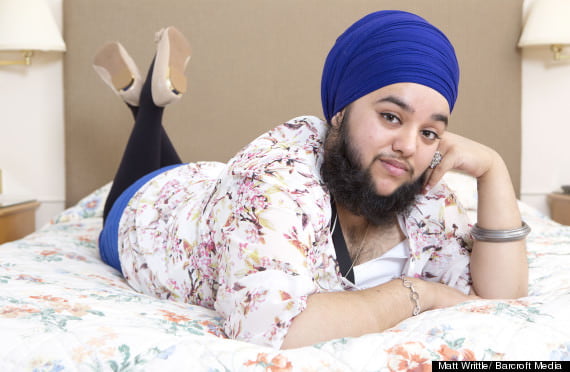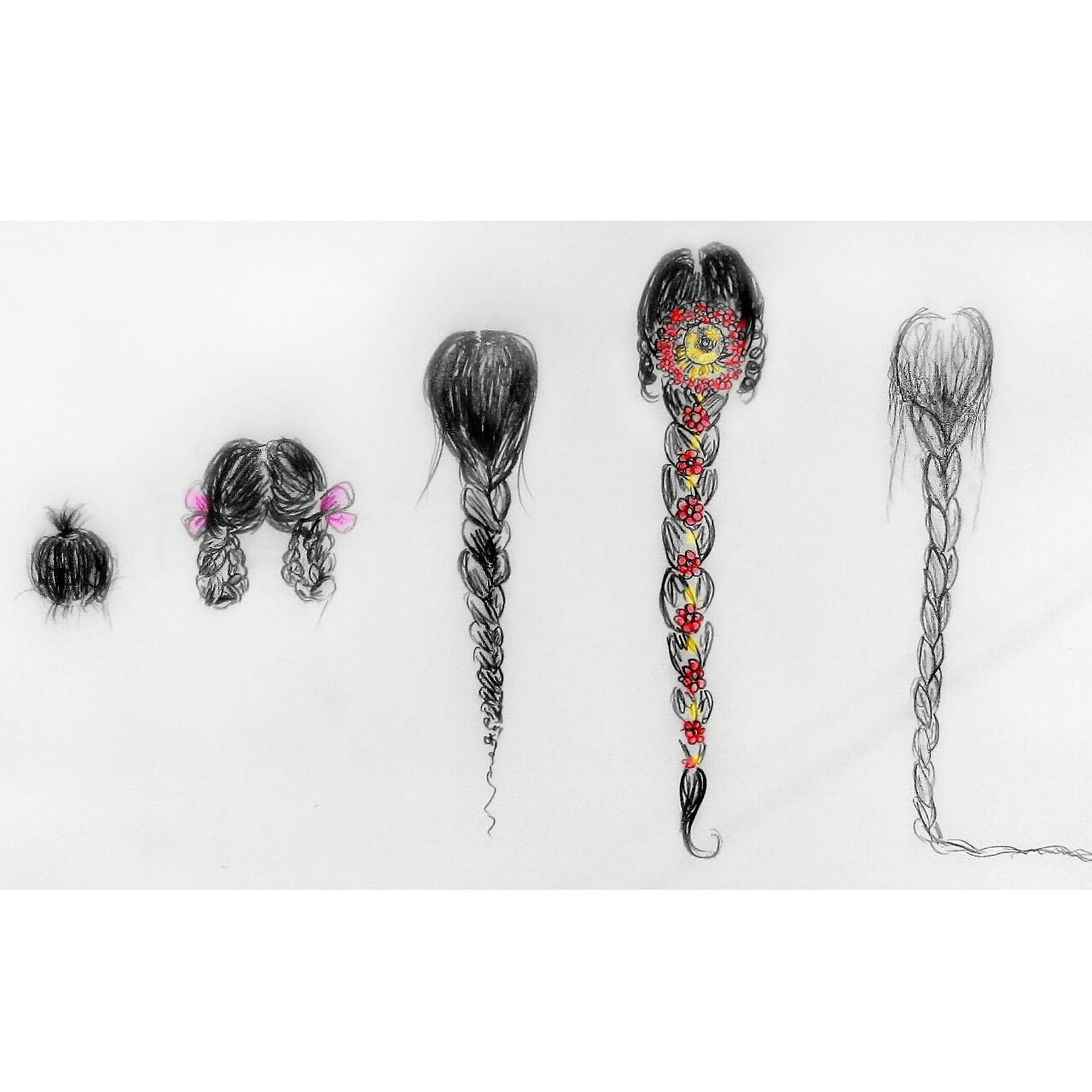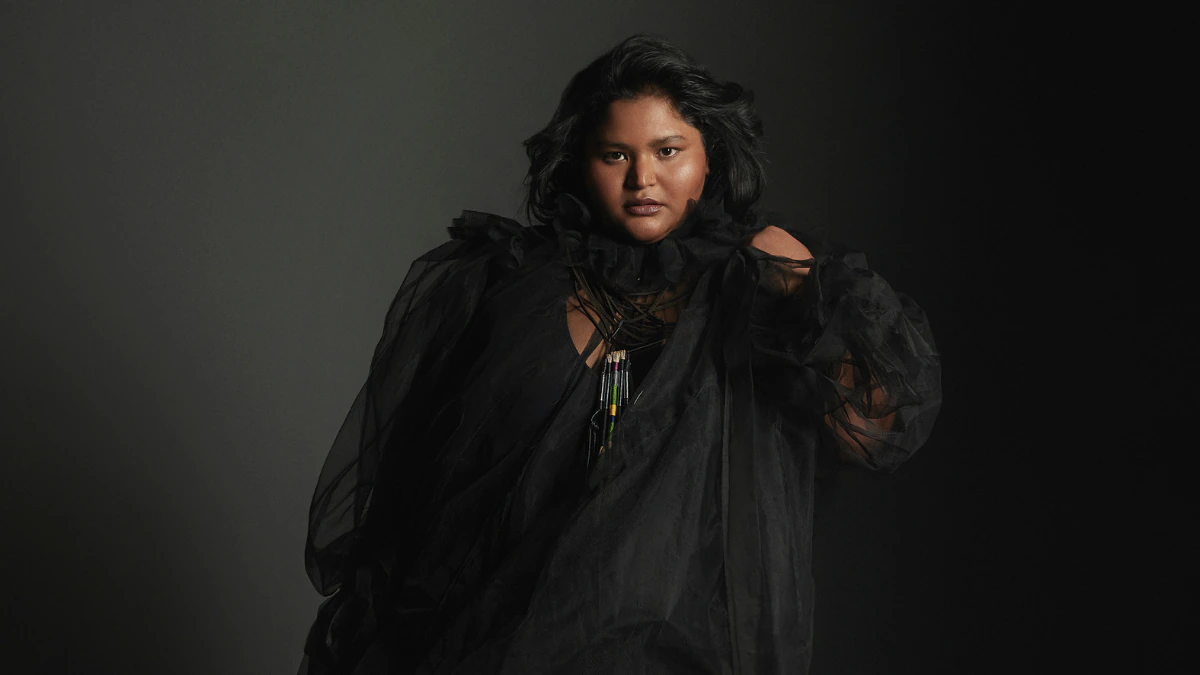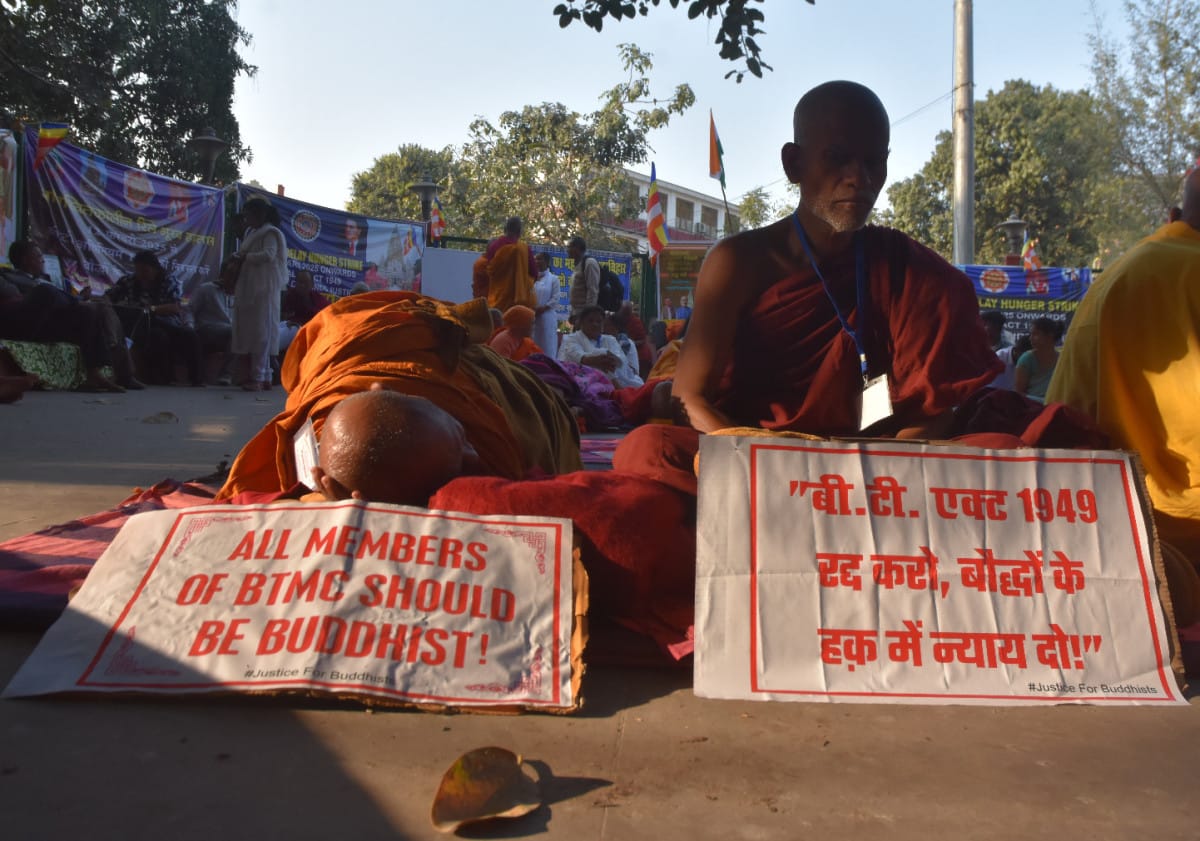One of the most distinguishing features about Sikhs is the practice of keeping long uncut hair (kes). Some women, do not cut the hair on their head, some do not cut or trim any hair at all, while others cut their hair. With any religion, people practice it to the degree they want to or are comfortable with. But the way women practice kes in Sikhism is policed in a specifically gendered way. It’s less about religion and more about keeping relatives and society happy while enacting an acceptable morally pure version of feminine behavior. It’s the reason why many Sikhs don’t have a problem with waxing or shaving, but cutting hair on the head would not be socially acceptable. Yet, keeping too much hair, makes you not feminine enough. Which forces Sikh women, both who chose to be Sikh and are born Sikh, into being constantly policed on what they do with their hair.
The way women practice kes in Sikhism is policed in a gendered way. It’s less about religion and more about keeping society happy while performing femininity.
I myself, am a keshdari Sikh, which means I have never cut my hair but I don’t wear it in a turban nor have I taken amrit (been baptized). The tradition of keeping hair goes back to the birth of the Khalsa, where Guru Gobind Singh, the tenth Guru of the Sikhs established a code of conduct for all his followers. One of those aspects was the establishment of the 5K’s: Kes (hair), Kanga (comb), Kara (iron bracelet), Kirpan (small dagger), Kachera (underwear). While I could analyze and go into depth on the symbolism and analysis of all five of these articles of faith, I’m only going to focus on Kes for this piece.
There are two main reasons why Kes became one of the 5 K’s in Sikhism. First, as a reminder to appreciate God’s natural creation, which in my understanding is the symbolic reason. And the second reason for keeping hair is due to the heavy persecution Sikhs were facing at the time. The turban and hair became an identity marker, which made people easily identified as Sikh so people were able to uphold their faith. It also forces people to be held up to a higher standard. Thus, you not only have the pressure of living up to yourself but you also have to live up to your religion everywhere you go.
Also Read: 5 Sikh Women in History You Should Know About
Guru Gobind Singh also asked people to begin wearing the turban, something Sikhs had already begun to do, in an attempt to mimic the Gurus styles. The turban was chosen because at the time they were a symbol of aristocracy, and allowing women and lower-caste people to wear it aimed to abolish the structure within itself.
Then, why is it that most Sikh women do not wear the turban? Technically, we should be wearing them too. But the way women’s kes practice is policed in Sikhism is specifically gendered. Of course, people practice religion to whatever extent their comfortable with. But wearing a turban makes a woman “too masculine” and cutting her hair somehow makes her “morally loose”.
Wearing a turban makes a woman “too masculine” and cutting her hair somehow makes her “morally loose”.
The way kes is performed for Sikh women is currently heavily influenced by patriarchy. The ideal Sikh woman for most Sikhs (of course this varies), is one who keeps the hair on her head but still removes facial and body hair. Thus, for women who question this logic and cut their hair are shamed by masculine Sikh clergy as “going to the West” which also implies some kind of loose sexuality or morality, without interrogating any reasoning further than that.

On the other hand, women who chose to keep their body hair or choose to wear the turban are seen as masculine and not fit for marriage. Both visions are tied to sexuality and gender appearance. It is also important to note, that these expectations morph depending on your family and circumstances if you are born into a family where all women wear the turban or a family where all women cut their hair your expectations will shift based on your own family’s interpretation of how women should act.
This moral policing stops having anything to do with Sikhism, and more about morphing what people interpret as Sikhism to police and dictate what women should and shouldn’t do. Because if it was about Sikhism, people would not be dissuading their daughters from taking Amrit and wearing a turban.
For me keeping my hair is firstly out of my dedication to the Sikh religion, but even when I went through my own phase of coming to terms with religion I never once considered cutting my hair, and that was because even if I wasn’t sure about the faith aspect of my tradition, it was the cultural heritage that mattered to me more. It’s also a political choice for me as it is both a post-colonial choice against assimilation as someone who lives in the West, as well as a push back against Hindu nationalism.
The ideal Sikh woman for most Sikhs, is one who keeps the hair on her head but still removes facial and body hair.
That being said, I still wax my legs and underarms and occasionally thread my upper lip. Where does Sikhism fall in that? It has not been easy for me, with lots of weird hostility and strange questions from non-Sikhs. But, I do not have to face as much hostility from my family, as they all perform Kes in the same ways I do, even if not for the same reasons.
In this way, I know I almost have the ideal Sikh practice. I’m policed in a numerous of different ways, but not in terms of my hair. I’m not cutting my hair on my head, but I’m also removing enough hair to properly perform femininity. Thus it’s important for me to acknowledge my own positionality.
Yet when I refuse to pluck my eyebrows or wax my arms I am literally bullied about not doing it from a variety of different women in my family.
Many Amritdhari (baptized) women who wear a turban are regulated for wearing revealing clothes because they have made this choice to become baptized despite the fact that people are okay with Amritdhari men walking around in shorts.
Women who chose to keep their body hair or choose to wear the turban are seen as masculine and not fit for marriage.
Amritdhari Sikh woman Harnaam Kaur, who is based in the UK has been very popular on social media recently because of her body positivity. She has PCOS (Polycystic Ovary Syndrome), which causes people to grow excessive facial hair. She talks about how when she wanted to get baptized, her family discouraged her because they didn’t want her to stop removing her beard. She is quoted in The Huffington Post saying “My mum and dad didn’t want me to do it – they didn’t think I’d be able to have a normal life if I had a beard. They worried I wouldn’t be able to get married and that I’d never get a job. But I wanted to make my own decisions and live for myself – not anyone else.”

Here the gaze of patriarchy on Sikh women is dictating both acceptable and not acceptable hair practices. When it comes to women who want to cut their hair, they’re policed for not being religious enough, yet on the flip side of this, women who keep hair that isn’t seen as “feminine” are also warned that they might not find a husband. What is our practice if we only look at our presentation through this heterosexual male gaze? And how does the equalizing tradition of Sikhism work through this lens?
I’ve used the phrase performance throughout this piece to highlight that keeping hair is the most outward expression of Sikhism. Yes, it displays your own connection to God and how spiritual you may be, but it doesn’t guarantee that. More important values of Sikhism are Wand ke Chako (help people in need), Naam Japo (remember God), Kirat Karo (earn an honest living), which is not related to keeping your hair. You can be a good person and cut your hair, and you can be a terrible one and keep it. So using hair as the sole marker of someone’s “Sikhism” is problematic. In my opinion, as a practicing Sikh, keeping your hair is one of the simplest aspects of following Sikhism, and doesn’t measure much.
You can be a good person and cut your hair, and you can be a terrible one and keep it. So using hair as the sole marker of someone’s “Sikhism” is problematic.
Sikh men have also told me that I don’t need feminism because Sikhism has already established us as equals, and to that, I question why women are still policed in this specifically gendered way, in which everything boils down to how they are viewed by men. You cannot be too morally loose, and you cannot be too masculine.
The most important thing is to understand how the tradition works for Sikh women, not how Sikh women work for the tradition. It’s important to do what empowers you, whether that’s keeping all of your hair, some of your hair, or none of it. And make sure to question family and practice. Sikhism isn’t a definite thing, it’s a journey and a process and it’s important to allow women, trans* and non-binary people to practice or not practice Sikhism without the glare of patriarchy.
Also read: Sikh Names: Beyond Gender, Caste And Patriarchy
Featured Image Credit: An Unshorn Lineage by Anoop Caur
About the author(s)
Jasveen is currently a student at the New School studying poetry, race and ethnicity, and gender studies. You can find her either in New Delhi or New York. She's interested in gender justice, religion, diverse art, and class reform. Her twitter is: @jasveenflies





Well written article Jasveen! Shines light on a lot of points I totally agree with. In the end, I believe we should do what feels right inside and not be afraid of judgement and pressure from family or society. Being victim to outside pressure and trying to please everyone, only leaves us lost in the middle while not truly being happy or fulfilled ourselves. Its important to remember its really only God who sees us in whole, people only see what they want to see.
You kept hair as push back to “Hindu Nationalism” but Guru Gobind Singh kept them to give Hindu Dharma’s fighting force a different identity. Basically, you neo-Abrahamist Sikh lot are as far removed from Sikhism as Feminism or Islam is.
Interesting article Jasveen! I for one was surprised at how you have chosen to keep your hair as a push back to Hindu Nationalism, but once I digested it, it made sense to me. I’m pretty fed up of the recent wave of hyper- Hindu nationalism myself, so more power to you young lady!
Just to give you some context, I am a non practicing Sikh lady in my 30’s, who went to a Sikh school as a child and rebelled ferociously against the constant gender and moral policing I faced in Sikh society right from babyhood. (Not to mention outright skin based racism because I was considered ‘dark’, ‘ugly’, and less than human than the ‘pretty’ (whatever that means) fair skinned Sikh girls in my class). I feel blessed to be one of the few who challenged what I was taught, and went against the norm as a teenager and decided to throw off the shackles people had placed on me as a young child – and it has made all the difference to me as an adult. I sometimes feel sad being unable to follow the wonderful religion I was born into, but to do so inevitably has me being exposed to, lectured and policed by other hype religious Sikhs whose narrow mindedness and mysoginy is far too much for my progrrssive soul. So I have chosen the non-kes way of being myself, while keeping close to me the values that I learnt from Sikhism – I have defiantly cut my hair most of my life and will continue to grow it as long and short as I please. No one tells me what to do with my hair, or how good a Sikh that makes me!
I do have a soft spot for my kara, it never leaves my arm, and reminds me to look beyond ‘societal’ ideas of Sikhi, and go straight to the core of Sikhism – be a good person, respect everyone whoever they are, don’t put your faith in empty idols (which I see as a synonym for human idols, raising another human being to Demi-God status), hope and work for peace and harmony but stand up for yourself if you must. Even to those who claim to be guardians of the faith you were born into.
While I am sure you will not agree with everything I have said, I wanted to let you know – I respect your right to intepret the Sikh faith in your own way, as much as I respect mine to do the same. And ginormous respect to the young lady you mention in your article who chose to grow her facial hair after being baptised!!! Time each one of us got to choose how to follow religion for ourselves, don’t you think? 🙂
PS. For any over eager beavers ready to take my experiences as proof to bash Sikhism, sorry to disappoint you but I got fed up of ALL religous orthodoxy as a teenager and especially hyper religious folks (yes, I’m looking at you Hindutva “India is for Hindus” types! Sorry buddy, I don’t much care for your brutish ideas either), whatever their religion. I am immensely grateful to have been born Sikh, and even though I have largely left my birth religion behind and chosen to be non-religious, having studied the Sikh religion and history as a child helped me become an impassioned humanist as an adult. How awesome to have served Langar as a child and learnt how to respect every single human there – irrespective of gender, age, religion or caste!
This is a great article. I always had questions about Sikh women growing or cutting their hair and never got clear answers from sikh friends. I never probed too much because I was afraid of being rude. This article provides all the answers. Thanks!
I agree with you. My father wouldn’t allow me to wear t-shirts and jeans to Sikh temple. Then I asked him why men are allowed to wear t-shirts and jeans. He had no answer. Now I don’t go to the temple anymore because they would put up signs for women what to do but never for men!
It’s answer is simple, our parents say wear decent clothing in temples/gurudware anywhere.
Which means by decent clothing as we our going to our guru there is no point of show off(which most people are doing while going to gurdwara) secondly, decent clothing meaning so that any person is not distracted( that may b due to clothing , or when mostly people do while bowing putting there hand at the back , covering the body)
To avoid all this..which is very much basic..